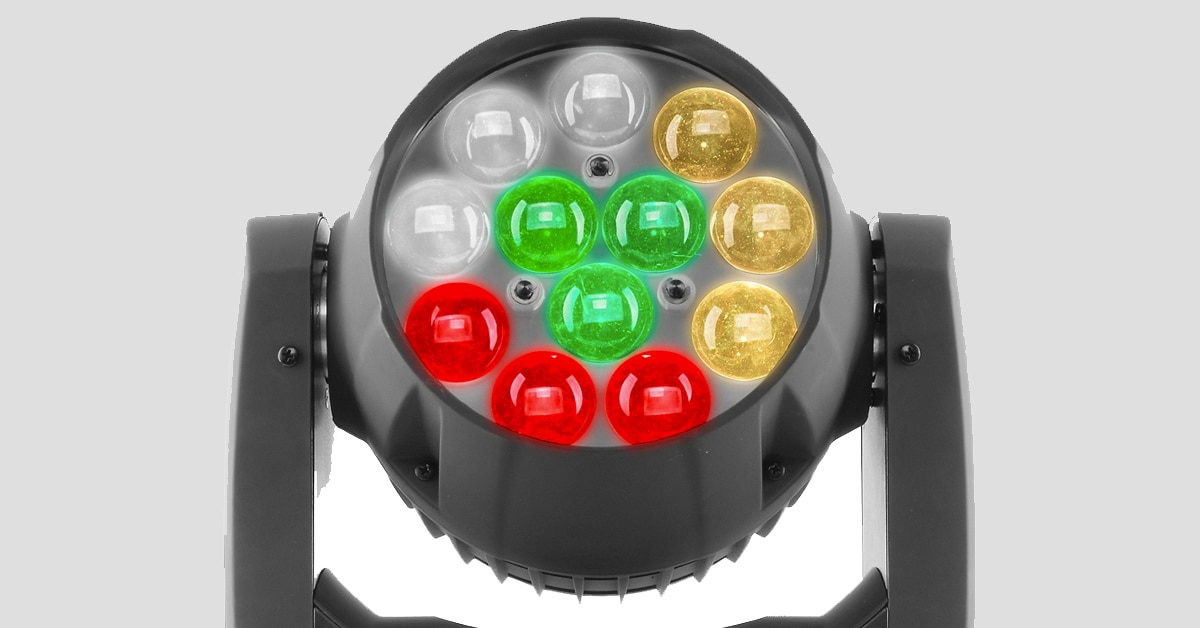A well-designed lighting system and carefully chosen stage effect lights can inject a huge measure of drama and excitement into your show. With a relatively small investment, adding a visual dimension to your music will give your performances a professional sheen that’ll captivate your audience. Whether you’re looking to light a band, DJ show, nightclub, house of worship, or your man cave, there’s a huge range of lighting effects and equipment available today to match your budget and the mood you want to create. With this lighting guide we’ll cover the equipment, terminology, and technology that can help transform your show or setting from average to extraordinary.
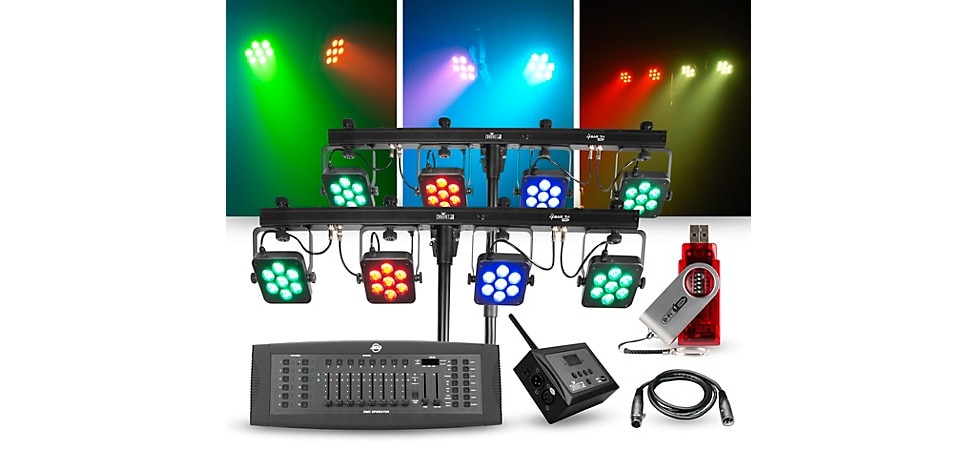
The CHAUVET DJ Lighting Package includes two 4BAR Tri USB LED Fixtures for wash lighting, an Elation DMX Operator, D-Fi Hub and D-Fi USB transceiver.
Table of Contents
Assessing Your Lighting System Needs
LED vs. Conventional Lighting
Types of Lighting Effects
Spot/Hard/Edge Lighting
Wash/Soft Edge Lighting/Color Changers
PAR Can Lighting Fixtures
Dimmer/Switch Packs
Atmospheric Effects
Lighting Effects Packages
Lighting Controllers
Lighting Strategies
Assigning Effects and Programming Shows
Connecting a Controller to Lighting Fixtures
Lighting Hardware
Lighting Cables
Lighting Cases and Bags
Lighting Glossary
Assessing Your Lighting System Needs
In putting together your lighting system, it’s useful to consider what you want to achieve. Here are some questions to ask yourself:
- What kind of spaces, acts, and events will I be lighting?
- What kind of ambience do I want to create? Exciting? Dramatic? Mysterious? Soothing? Solemn?
- Will I be lighting indoor or outdoor events or both?
- Will there be access to AC power; how many outlets and how much amperage will my lighting require?
- What existing lighting equipment do I have?
- Do the venues I’ll be working in have their own lighting systems?
- Who will handle lighting setup and control?
Regarding the last question, if you’ll be handling your own lighting during performances, features such as remote control, foot pedal control, and programmability will be important considerations.
LED vs. Conventional Lighting Fixtures
Traditionally, most modern lighting fixtures either worked by electrically heating a filament or sending an electrical discharge through a gas or plasma to create artificial light. Filament-type lights range from the ordinary household light bulb to powerful halogen lamps. The most common gas discharge lighting is the ordinary fluorescent tube. While both types are still very commonly found in all kinds of lighting applications, LED technology has made big inroads in recent years.
Inexpensive LED fixtures typically have smaller, low-power LEDs while larger, high-end fixtures are equipped with one-watt or three-watt diodes for much more impact. Smaller LEDs are often designated by their sizes—typically 5mm or 10mm. A 10mm diode is proportionately much brighter than a 5MM LED.
Light-emitting diodes or LEDs have revolutionized all kinds of lighting fixtures from those used in autos and homes to even the humble flashlight. For many good reasons, the LED’s impact on stage lighting and effects has been huge. Major acts such as Radiohead have recently toured using LED lighting exclusively. Let’s look at LED lighting’s advantages and disadvantages in comparison with traditional lighting:
LED Advantages
Power consumption: LED lighting fixtures and effects use far less electrical power than filament-based lamps. Aside from their obvious environmental benefits, LEDs offer a big advantage when performing in venues with limited electrical circuits. Having your traditional lighting fixtures trip the venue’s circuit breakers in mid-performance is an embarrassment to be avoided at all costs! You can usually connect several LED fixtures to a 20-amp circuit without fear of an inadvertent blackout.
Heat: LED fixtures generate little heat making for a much more comfortable performing experience. They eliminate the potential for burns and damage to adjacent gear that can be inflicted by super-hot halogen lamps.
Color versatility: Many stage lighting and effects fixtures contain multiple red, green, and blue (RGB) LEDs. As with modern TVs and computer monitors, these basic colors can be controlled and mixed to produce 16.7 million different colors. The addition of amber and/or white LEDS allows you to control the apparent “warmth” of the light. This color versatility far surpasses the possibilities of conventional stage lighting that uses colored gel sheets to filter white light.
Dimmerless control: Due to built-in dimming circuitry, the light intensity of LED fixtures can be controlled directly when they’re used in standalone mode. When used as part of a system, LED lights and effects can be dimmed using DMX controllers without the use of separate dimmers.
Durability/longevity: The life expectancy of LEDs far exceeds that of traditional lighting. LED fixtures also tend to be more durable since there are no fragile lamps or filaments that can be damaged during rough handling or transport or by vibrations.
Daylight visibility: Generally speaking LEDs are more visible in bright daylight, making them a good choice for outdoor use.
Types of Lighting Effects
Most entertainment lighting falls into one of three basic categories based on their functions: effect, spot, and wash lights. They are further grouped into DMX and non-DMX fixtures, which we’ll discuss below. Effect lights are generally defined as lights that use multiple beams and motion in order to create a desired effect. Effect lighting is intended to enhance a show, not to illuminate a particular area or person. Some lights in this category include moonflowers, gobo projectors, and classic “derby” lights.
Here are some of the common lighting effects types you’ll encounter:
Gobos: A gobo is a physical template, usually spherical in shape and made of metal or glass, that has slots or holes designed to control the shape of light beams that pass through it. The light source is either placed within or behind the gobo to create patterns that can be projected onto walls, floors, or ceilings. Some gobo-equipped projectors can change beam colors, and many have motors that rotate the gobo to create dynamic effects. Anyone who’s been in a dance club full of swirling patterned light beams has likely witnessed gobo lighting effects in action. Many different types of effects incorporate gobos that enhance their versatility.
Beam Effects: These lights have different colored lenses positioned around a central light source embedded in a spherical or half-spherical fixture, also known as a mushroom. Beam effects can have one or more motorized spheres spinning around the lamp continuously, Some can vary the direction of the spin based on sound received by a built-in microphone; for example, changing direction with each kick drum beat. When used in conjunction with fog, colored beams are extremely effective.
Flower Effects: These are standalone fixtures that usually allow you to adjust parameters such as beam color, gobo type, rotation, and lamp, all of which can then be controlled automatically by a built-in microphone. The effect can be set to rotate, remain static, or be triggered by specific audio frequencies. The lack of DMX control makes flower effects less suitable for larger venues, but their simple installation and operation make them very attractive for smaller locations as well as bands and DJs who control their own lighting.
Centerpiece Effects: As the name suggests, a centerpiece is a fixture designed to be located in the center of a lighting rig, usually directly above a dance floor. Their designs are based on a central lamp surrounded by mirrors that reflect light in all directions. Various mirror types can be employed to change the appearance of the effect. They tend to work well alongside flower effects, and like them, control of color, direction, and gobo type are synced to audio via an internal mic. Some centerpieces are not DMX-controlled, while others offer full DMX control of all functions.
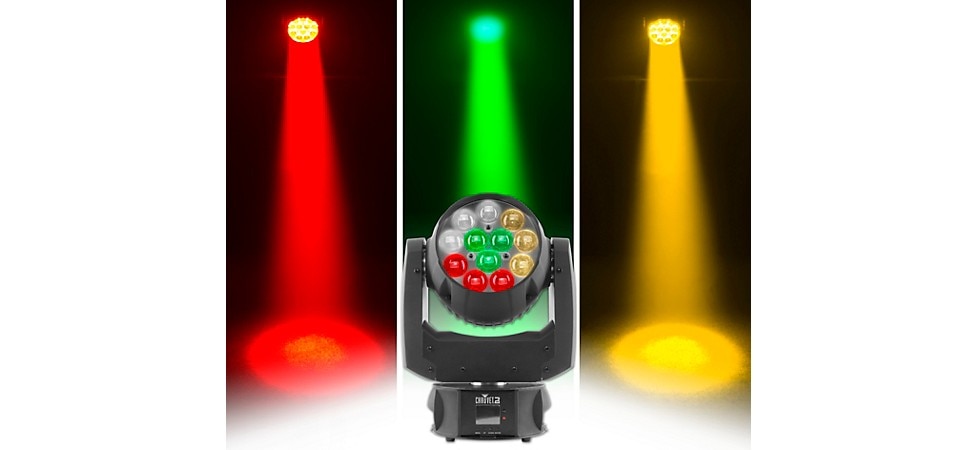
The CHAUVET DJ Intimidator Wash Zoom 450 IRC RGBW LED Moving-Head Light features 12 15 watt RGBW LEDs and includes a Totem mode to keep beams directed at the dance floor. It can also be controlled wirelessly.
Scanners: These fixtures incorporate a user-controllable mirror that can be programmed to pan and tilt in any direction within the range of the fixture. As well as control of the mirror, some models offer DMX control of color, gobo, and focus. Most also have preset programs. Because the only moving part in a scanner is its mirror, they typically move much faster than effects with moving yokes or heads.
Barrel Mirror Effects: Closely resembling scanners, they feature a rotating barrel mirror to create a continually falling beam. Just like flowers and centerpieces, color, gobo type, and mirror direction can usually be synchronized to the music via a built-in microphone.
Mirror Balls: Also known as disco balls, these rotating effects have been around since the 1920s, showering dance floors with hundreds of sparkling lights. Pin spots are typically used to create the reflected beams that bounce off the mirror ball, and some balls come complete with appropriate spots. Some modern LED fixtures mimic the effect of traditional disco balls as well as adding strobe and sound-active modes plus bi-directional movement.
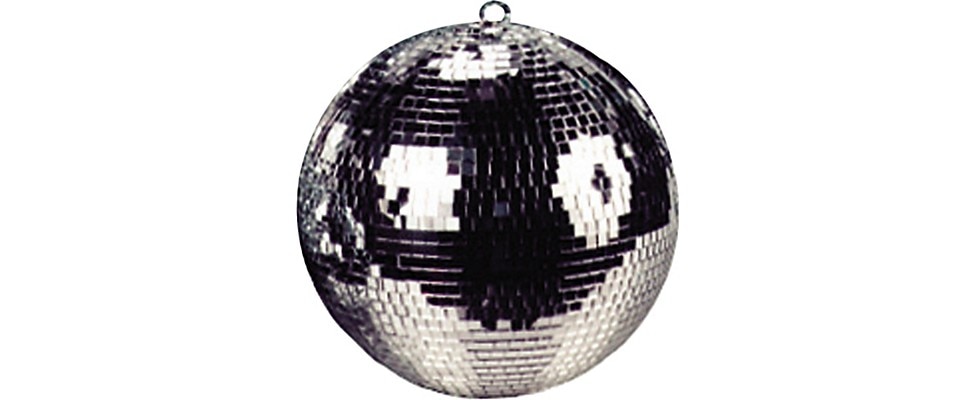
The American DJ M-1212 Mirror Ball is a classic dance floor effect. Just add a pin spot to get the party going!
Moving-Yoke/Moving-Head Effects: Sometimes referred to as intelligent lighting, these DMX-controlled effects function similarly to scanners (see above). However, instead of a beam of light reflecting off a moving mirror, the entire fixture moves. The moving yoke is generally slower than a scanner since it has more mass to move as opposed to a lightweight mirror. Like scanners, the color, gobo, shutter, focus, and movement are controlled via DMX. When shopping for a moving-yoke fixture, pay close attention to the quality of the optics and the number of colors and gobos provided. More advanced moving-yoke effects often incorporate rotating gobos and prisms, and a number of color wheels. These features allow complex effects and sequences to be programmed. They can be be operated in sound-activated and can be daisy-chained so multiple units can be operated in unison. They are available as spot, wash, and beam fixtures, or combinations of all three.
Strobe and Laser Effects: Strobe effects use a pulsing white light beam to create a visual stuttering effect similar to viewing old-time films. They’re very popular in dance clubs and are available with both traditional filament bulbs as well as LEDs in a range of power levels to match various venues. You can choose from standalone models or DMX-controlled strobes that can be programmed with custom patterns. Sound-activated models can create a particularly exciting ambience on the dancefloor. Note that many LED PAR cans and effects lighting fixtures include strobing functions that may be adequate for your needs.
Laser effects produce very intense single-color beams and often include built-in display programs as well as sound-activated functions using a built-in mic. Motorized units allow scanning and burst effects, and the inclusion of gobos can create patterned laser beams. More advanced laser effect fixtures can produce 3-D effects and detailed backdrops, skyscapes, and much more. Lasers are especially effective when used in conjunction with fog machines.
Spot/Hard Edge Lighting
Spot light Fixtures: They are used to illuminate a particular person or area in a narrow beam that does not bleed light into surrounding areas. Spot fixtures range from simple PAR-style units (described below) equipped with a narrow-beam spot bulb to more advanced designs that can be operated remotely using DMX programming. They may also include gobo effects and operate in standalone or sound-active modes.
Followspots: One the best-known example of a hard edge light, they also fall into the spotlight category, and are used for productions of all types. In order to follow a particular feature or performer across the stage, a followspot projects a very narrow beam that can be moved by an operator.
A majority of lights that feature gobos are also considered hard-edge lighting as they can be used to light a particular area, or project a particular pattern in a defined area on walls, stage, ceiling, or flooring.
Wash/Soft Edge Lighting/Color Changers
Wash lighting is used to create an overall ambient lighting scheme. If you want to transform a plain white wall to a different color, a properly mounted and programmed wash light is what you are looking for. Fixtures range from simple PAR-can units that project a handful of colors to more sophisticated units capable of subtle color shifts choosing from thousand of color combinations and multiple lenses.
Most wash lighting and color changer lighting fixtures can be either set set up on the stage or mounted on a truss depending on where you want to direct the lights. They are available in a broad selection of formats from rectangular color bars to square panels to spotlight-like fixtures. Spot-type wash lights are a good choice for mounting on overhead trusses. Bar-shaped units are ideal for wide color washes on backdrops and curtains.
Some units are equipped with traditional lamps while many models today feature LED lights. As discussed above, LED units offer the advantages of lower power consumption without the heat generated by traditional lighting fixtures. Most LED wash lights are programmed to mix various combinations of their red, blue, and green (RGB) LEDs to produce many hue variations. Fixtures designated as “RGBA” include amber LEDs that allow you to control the relative warmth of each color.
LED panel fixtures are often especially versatile since many models feature multiple sections with individual color control.
With their broad wash of colors, they are excellent choices for backlighting and sidelighting.
As with effects lighting, many wash and color changer lighting fixtures can be sound-activated and some also include strobes adding to their versatility. If you play on stages that vary substantially in width, having several wash units that can be daisy-chained together can make sense to handle various venues. Some LED fixtures can be battery powered—a big advantage when playing outdoors or when access to AC power is questionable.

The CHAUVET DJ Freedom Par Quad-4 Battery-Powered LED Wash Light can run in wireless or DMX modes and has 20 watts of RGBA color mixing.
These fixtures are a simple, low-cost way to add a special ambience to performance spaces and other venues. They enhance the appearance of white and fluorescent colors in darkened spaces creating a ghostly glow. Black lights are available in standard fluorescent tube and incandescent bulb formats that use standard lighting fixtures as well as newly developed LED fixtures.
PAR Can Lighting Fixtures
These lights are a staple of stage and live-sound lighting. These basic fixtures have a metal housing, mounting bracket, reflector, and socket that can accept a variety of different lamp types. They’re often used in large numbers to illuminate certain performers or stage areas and are usually mounted on overhead trusses. They do not offer a true hard-edge beam; the width of the beam is determined by the shape and positioning of the PAR can’s reflector.
PAR cans come in a wide range of sizes and are identified by their diameters in eighths of an inch. A PAR64, for example, has an 8" diameter (because 64 eighths of an inch equals 8"). Most include a holder allowing colored gels to be mounted in front of the lens.
Lamps for PAR cans come in a range of beam spreads that are denoted by the following abbreviations:
- VNSP (Very Narrow Spot)
- NSP (Narrow Spot)
- MFL (Medium Flood)
- WFL (Wide Flood)
Note that PAR38 lamps are sometimes designated as simply SP (Spot) or FL (Flood).
The power requirements of PAR cans with incandescent lamps can add up fast. Those for smaller stages are typically in the 75-150 watt range. PAR38 cans typically run between 50-150 watts. PAR46s usually have 200-watt lamps, PAR56s usually range from 300-500 watts, and PAR 64s range from 500-1000 watts. This is where the LED technology really shines (pun intended). They not only use a fraction of the power required by incandescent fixtures, but also reduce the number of fixtures needed in order to create a wide range of color options.
A common lighting setup for bands involves the use of a pair of light trees on either side of the stage, each holding enough PAR38 cans with spot lamps and amber or light pink gels to light each frontline band member. Drummers are usually lit from the back and sides. Mounting the light trees to the tops of your main speakers is a space-saving strategy.
PAR cans and other lighting fixtures that have a double-yoke support system are something to look for if you want maximum placement flexibility. Double yokes allow mounting the fixture from a truss or placing it on a floor, speaker, or stage without a separate mount.
Today, many PAR fixtures are equipped with LEDs instead of traditional incandescent bulbs, giving them multi-color and color-mixing options. As noted above, PAR cans with LEDs generate much less heat, require far less power, and don’t require the use of dimmer packs.
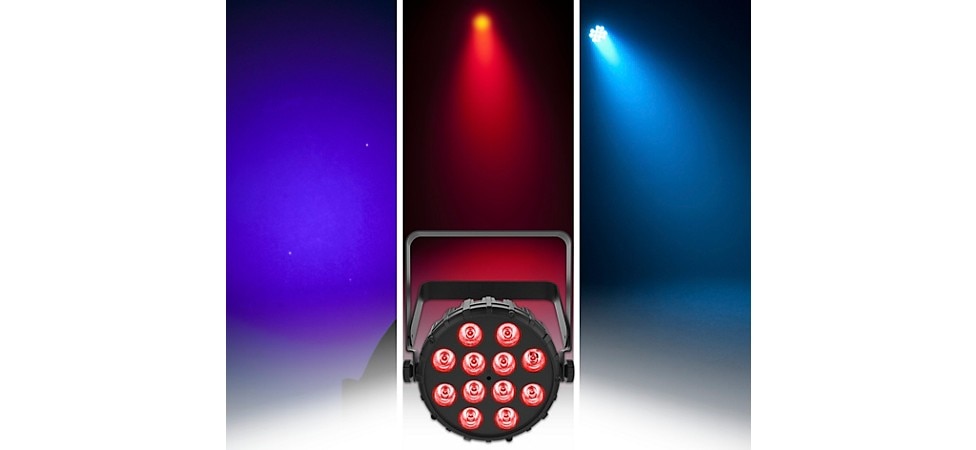
The CHAUVET DJ SlimPAR T12 BT RGB LED PAR Wash Light has 12 tri-color LEDs and can be controlled via Bluetooth from your smart phone or tablet.
Dimmer and Switch Packs
PAR cans with incandescent lamps require dimmer packs to control them. They operate in the same way household dimmer switches function, allowing you to set the relative brightness of connected lights. Most small bands and DJs use satellite dimmer packs with several channels that are typically mounted to the T-Bar or truss holding the PAR cans. The cans are plugged into the dimmer and they’re connected to a DMX controller. Dimmer packs are available with various numbers of channels, and some include built-in programs or chases.
Some units offer both dimmer and switch capabilities. Switches only provide on/off functions, and should be be used on LED and non-DMX effects fixtures to avoid shortening their life.
Atmospheric Effects
These effects can be used alone, but are often especially effective when used in conjunction with the right lighting fixtures to transform the ambience of a performance space. We’ll cover the most common types next.
Fog Machines: Fog generators enhance the impact of other lighting, especially lasers and other effects that project beams through the air. This enhancement means you’ll likely to be able to achieve greater visual punch using fewer lighting effects. There is a point of diminishing returns with fog machines though. Too much fog can trigger smoke alarms and an overly dense cloud of fog can actually diminish the overall impact of your light show. As with lighting effects, remote control of fog machines can be a big advantage, especially for bands and DJs who operate their own lights. Fog machines that have controls to set the duration and intervals between fog blasts will also help you optimize the amount of fog. Some fog machines include their own lighting effects making them an easily controlled all-in-one lighting solution. You can add another dimension to your foggers impact with fragrances especially made for them.
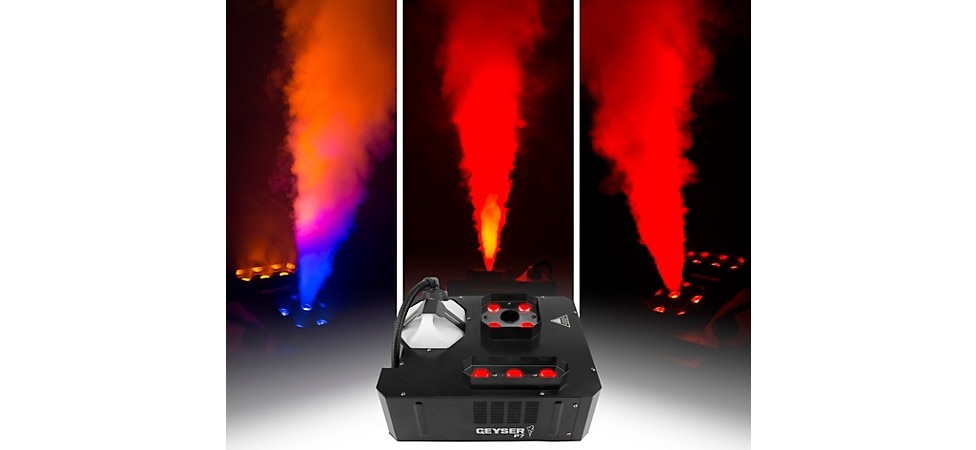
The CHAUVET DJ Geyser P7 Compact Fog Machine features seven 9W RGBA+UV LEDs, offering you plenty of color capability. It can be controlled from built-in DMX or the included Geyser wireless remote.
Haze Machines: Hazers create effects that are similar to fog machines while minimizing the potential drawbacks associated with fog. Haze is less dense than fog and so is less likely to activate smoke alarms if used properly. (Be sure to read your user manual, check your local regulations, and ensure adequate ventilation prior to operation). Hazers also generally maintain a more even and consistent effect than fog machines. Some units combine both haze and fog functions increasing their versatility in different settings.
Bubble Machines: They do exactly what you’d imagine: create bubbles. With multiple wands and a soapy solution, these little machines can produce a very festive effect. While they don’t enhance lighting effect the way fog and haze machines do, bubble machines are excellent for outdoor events, children’s parties, and weddings.
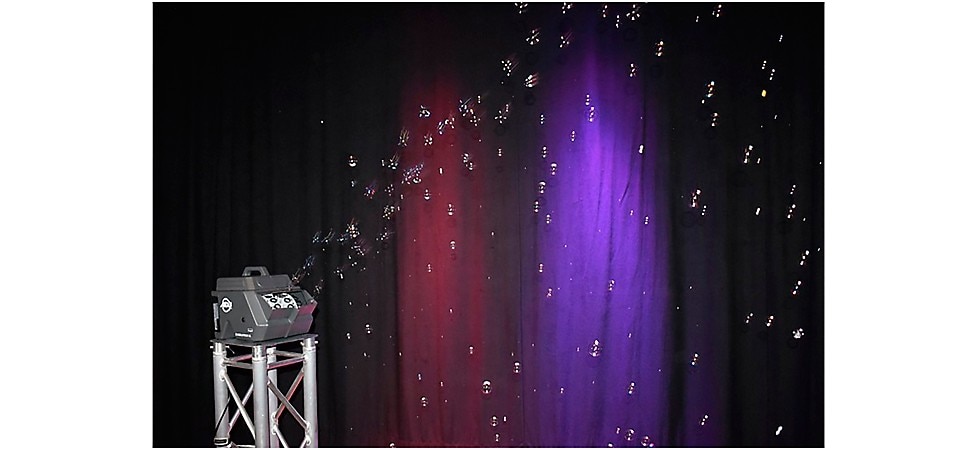
The budget-friendly American DJ Bubbletron XL is super portable and is at home at a bar, on stage or at a club.
Snow Machines: Used for indoor and outdoor events as well as onstage, snow machines generate a light, white substance with the consistency of snow. The simulated snow melts into a soap-based solution after reaching a surface.
All these atmospheric effects use special fluids to produce their output. If you tour, you’ll want to stock up on the appropriate “juice” to insure you don’t run out on the road.
Lighting and Effects Packages
On the Musician’s Friend website you’ll find affordable lighting and effects packages that range from economical multi-PAR can packs to full systems that include a complete set of stage lighting and effects fixtures plus a controller, stands, and cables—everything needed to light your show. Aside from the savings these packs offer, you can be sure each fixture is compatible and designed to maximize the overall visual impact of your performance.
Lighting Controllers
Regardless of the category a fixture falls into, entertainment lights are also classified as DMX or non-DMX fixtures.
Non-DMX Lighting
Non-DMX lighting fixtures have their own on-board controllers. Many such fixtures are designed to react to sound picked up through an internal microphone. Sound-activated fixtures usually include settings allowing the unit to create effects when insufficient or no sound is present.
Selectable, built-in programs allow you to automate non-DMX fixture operation—an advantage for bands and DJs who handle their own lighting. Fixtures in this category with incandescent lamps are often manufactured to operate for a specified period of time before they must be turned off, which may make it necessary to use multiple fixtures to create a continuous show. Look for the duty-cycle specification to determine if a specific model makes sense for your needs. This is another advantage of LED fixtures—they have no duty-cycle limitations. Examples of common non-DMX lighting include beam effects, flower effects, and gobo projectors.
DMX Lighting Fixtures
Also called intelligent lighting, these fixtures can be controlled via DMX-512 controllers or interfaces. A DMX controller allows you to program stage lighting and effects remotely, ideal when you want complete control of the look and timing of lighting effects. DMX fixtures offer more control attributes or “traits” than non-DMX fixtures.
DMX-512
DMX-512 is the communication/cabling protocol that most entertainment lights and controllers use to communicate with each other. DMX acts like a post office. For control, you assign an address between 1 and 512. However, unlike your house, which only has one address, your fixture needs a number assigned to each of its channels. A 6-channel DMX fixture uses 6 addresses, or 6 channels on a controller. Each channel on the fixture handles a specific control attribute such as pan, tilt, color, etc.
DMX Controllers
Controllers run the gamut from simple non-DMX switchboxes and relay packs that allow you to power multiple lighting and sound channels to highly sophisticated DMX units that provide control over every aspect of multiple lighting systems composed of hundreds of DMX-compatible fixtures. Some simpler controllers have a dedicated purpose such as controlling specific effects such as strobes or fog machines. Some controller models allow foot control—a great feature for solo acts and small bands who control their lights in realtime during performance.
The basics of DMX controller operation are generally quite simple. Each slider on the controller corresponds to a channel on the fixture being controlled. DMX fixtures have specific values that correspond to their various control settings such as color, gobo, pan, tilt, strobe speed, etc. By moving a slider on the controller to a specific value, the fixture follows suit. The various control values of each button or slider used to create an overall effect can be saved into a “scene”, which triggers the specific action or state you set. The scene is then saved into a memory bank. Numerous scenes can be combined into an entire program, which, for example, can be synchronized with cues for a show. This is called a “chase.” Chases can be adjusted via a myriad of input functions, depending on the controller being used. Examples of control triggers include MIDI and clock/calendar events.
Software-Based DMX Control
As with software-based audio recording and performance functions, there is a revolution in progress involving a shift in lighting control from hardware-based controllers to PC software and mobile device apps. That said, also as with audio functions, there are advantages and disadvantages to both approaches.
Dedicated hardware lighting controllers with physical sliders, buttons, switches, and legible displays offer intuitive and tactile control and workflow without delving deeply into menus and mastering steep software learning curves. On the other hand, software-based lighting control offers enormous control potential with nearly unlimited creativity in designing elaborate lighting programs. Software may also be more affordable route.
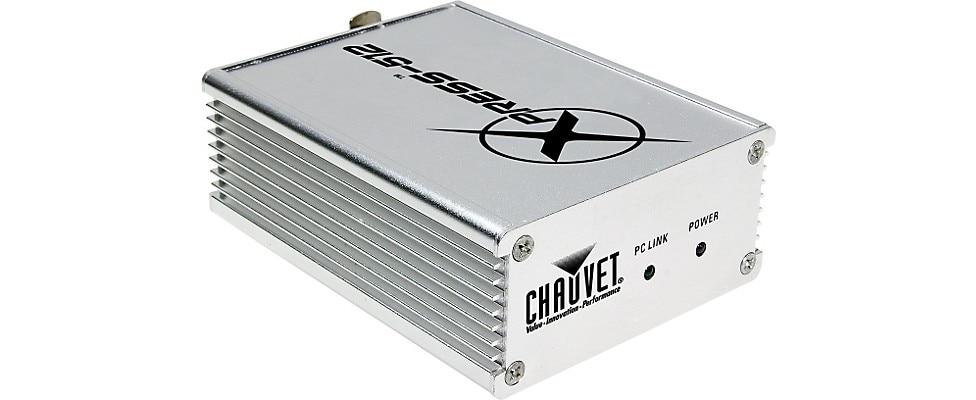
The compact Chauvet Xpress 512 Controller and USB Interface works with Windows or Mac computers and gives you powerful software-based control over an unlimited number of shows.
Many hardware lighting controllers come bundled with their own proprietary software and/or are compatible with other lighting software. Deciding which approach to lighting is right for your needs comes down to the complexity of your lighting and your willingness to master sophisticated lighting programming.
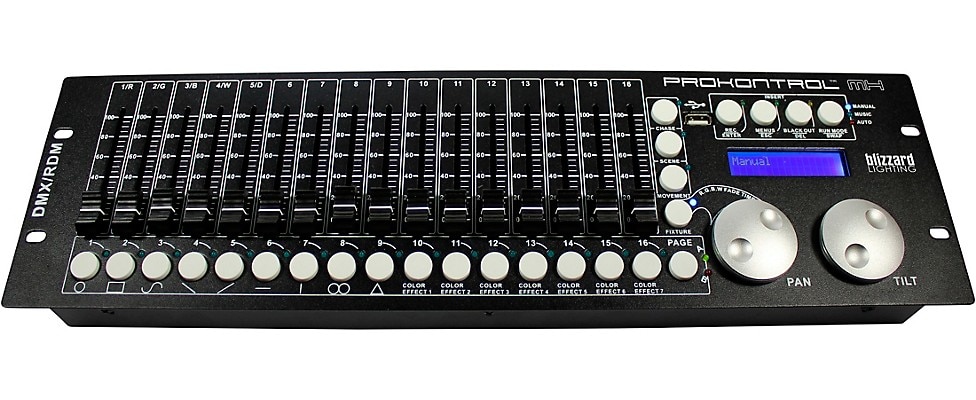
The Blizzard ProKontrol MH DMX Moving Head Lighting Controller can control up to 32 fixtures composed of 18 channels each. You can trigger your programs manually, automatically or by music.
DMX Controller Features and Specs
Here are some features and specs to look at when shopping for a DMX Controller:
Number of channels: Much like calculating the connections needed on an audio mixer, count the number of devices and each device’s number of channels in coming up with an adequate channel count. You’ll of course want to allow some additional capacity for future needs too.
Number of channels per fixture: Some fixtures have many control attributes or parameters. If you plan to include such fixtures in your lighting system, a controller that can handle up to 32 channels per fixture will make sense. However, if your system will be largely comprised of simpler effect fixtures and PAR cans, a smaller, DJ-type controller is likely to be adequate.
Number of programmable chases: Allows storage and recall of chase sequences simplifying show programming.
Number of programmable scenes: As noted above, a scene is a set of control values or slider positions that can be saved for instant recall. Some controllers allow scenes to be saved on external memory devices while software-compatible controllers offer scene storage and editing on external computers or tablets.
Number of programmable shows: A complete sequence of chases and other settings that comprise a complete performance that can be saved and recalled.
Number of universes: Each DMX network is called a “universe” and has up to 512 channels. Smaller controllers usually have a single OUT connector allowing control of a single universe. More complex lighting systems may be composed of several networks or universes thus requiring multiple controllers, or a single controller with multiple OUT connectors.
Fixture libraries: These collections of fixture profiles streamline the process of setting attributes and functions.
Tap/sync: This function allows the operator to sync lighting effects with the music by tapping in the tempo.
Joystick/trackball controls: These make tilt/pan and other positional functions easier to control.
Keyboard input: Allows connection of a computer keyboard for faster programming and naming of scenes, chases, and shows.
MIDI I/O and control: Allows control of the lighting system with a MIDI-enabled pedalboard, keyboard or other controller—a valuable feature for performers and DJs who control their lights in realtime. MIDI in and out connectors also facilitate programming on external computers and other MIDI-compatible devices.
USB Connectivity/Software-based DMX control: A USB connector plus MIDI implementation opens up a world of control possibilities using PC software and/or mobile apps to program and control your lighting.
Compact Flash drive: Enables updating controller software using downloaded updates.
Wireless operation: Some DMX controllers are compatible with wireless adapters so as to deal with situation where very long cable runs would otherwise be needed. Such systems have a wireless transmitter at the controller and receivers located near lighting fixtures. These systems convert DMX control messages to radio frequencies at the transmitter then convert the signal back to DMX signals at the receivers which are connected to the fixtures.
Lighting Strategies
Each fixture produces output at a specific beam angle, which denotes the width of beam being produced. Assuming that you have two fixtures with the same wattage lamps, the fixture with the smaller beam angle will appear brighter. This is because the same amount of light is being focused into a smaller area. In addition, because a smaller beam angle creates a more focused and intense projection, the light can be placed further from the subject being illuminated. The larger (wider) the beam angle of a fixture, the larger the area that can be covered by the unit.
Fixtures should also be placed in proximity to the subject based on output. Lights that have a lower output need to be placed closer to the subject than a high-output fixture in order to be perceived as having the same brightness.
Having a combination of wash and spot fixtures illuminating an area will greatly enhance the look of any show. By using contrasting colors, the spots will pop out more, appearing brighter within the wash effect than if used alone.
Assigning Effects and Programming Shows
The key to good lighting design is to mix and match fixtures and tones to create a desired mood and effect. When programming, use color schemes that complement or contrast with one another, depending on the mood you want. Using a wash to create an ambient light in a color that will complement your spot, or effect, will make it appear brighter and richer. Clean, crisp complementary colors, along with fluid movement and symmetry produce an air of professionalism. Contrasting colors add high energy and drama to a venue. The best way to increase your design skills is by visiting different venues and shows to see what other designers have done. Note the elements that struck you as the best, and attempt to emulate and improve on them.
Connecting a Controller to Lighting Fixtures
A DMX signal begins at the controller and follows the path of the cable to the first fixture and then to each fixture in line down the cable run. The following diagram shows the proper method and order for connecting multiple fixtures to a single controller. The DMX line pictured here runs from the controller to the “DMX In” connection on the first fixture. From the “DMX Out” connection of the first fixture, a cord is connected to the “DMX In” connection of the next fixture in the line, and so on until all units have a cable connected to the “DMX In” connection. The last fixture in the line should have a DMX terminator installed to maintain the quality of the DMX signal.
Lighting Hardware
When setting up your lighting, you need hardware that will safely and securely position and hold your fixtures where you need them. Raising your lighting fixtures increases their coverage and keeps them safe from accidental contact and damage caused by vibrations. Musician’s Friend offers a broad selection of clamps, mounting brackets, and safety cables to accomplish this.
If you perform in a variety of venues, it’s likely you’ll run into challenges in setting up your lights. Having an assortment of lighting stands can help make setup simpler. Basic T-bar stands with tripod bases make a good all-around lighting support. A pair of such stands with an integrated truss affords more positioning options, support, and stability. Read specs carefully to make sure that the light stand or truss system you choose is rated for the weight of your fixtures.
Lighting Cables
The fixtures you select will determine the cables required to connect your system. In general, you will need one power cord per fixture, along with the appropriate extension cords (if needed). In addition, if you are connecting your fixtures via DMX cable, you will need one DMX cable per fixture. DMX cables use XLR connectors and come in 3- and 5-pin varieties. Check the user’s manual of your fixtures and controller to determine which type will be needed for your application. It’s a good practice to have extra cables on hand to deal with failures and venues requiring longer cable runs. That goes for extension cords, switchboxes, and AC power strips too.
Lighting Cases and Bags
Once you start building your collection of lighting and stage effects, it is important to protect your investment. Transporting unprotected gear as well as storing it improperly can easily damage fixtures, lenses, and controllers. Purchasing lighting cases and bags such as these from Chauvet will help keep your lighting gear protected on the road.
We want you to be pleased with your lighting effects purchase, and offer a 100% satisfaction guarantee and generous return policy so you can order your new gear with confidence.
After reading this guide, if you’re still not sure which stage lighting or effects are right for you, we invite you to call one of our friendly and knowledgeable Gear Heads at (877) 880-5907.
Lighting Glossary
Attribute: a controllable parameter on a fixture such as gobo selection, color, tilt, pan, etc.
Barrel scanner: This effect fixture, also called a rolling mirror scanner, has a moving mirror that rotates around a drum with a beam that can be panned across its axis
Beam angle: The width of a beam of light, often designated by the number of degrees; the greater the number the wider the beam. Sometimes designated with qualitative terms such as narrow, medium, and wide.
Chase: A sequence of lighting effects or on and off sequences. A simple example is the apparent movement of theatre marquee lights along a string, caused by the rapid sequential illumination of each fixture.
CMY: System of light color mixing using Cyan, Magenta, and Yellow. This system entails the use of colored gels or filters to create a wide palette of colors. Also see RGB.
Color temperature: A measurement of how relatively blue (“cold”) or amber (“warm”) a given light is.
Color wheel: A circular metal disc containing colored glass filters and is motorized to rotate in front of a light source.
DMX512: The protocol used to control lighting systems and individual DMX-compatible effects.
Fixture: In lighting systems, any lamp or lighting effect is considered a fixture.
Focus: A qualitative statement of how relatively hard or soft a gobo’s projected image is. The hardness of a projected image is largely a function of the distance that the beam is projected; the greater the distance, the softer the image. Focus may also refer to the X/Y position of a moving light in relation to the performance space or stage.
Gel: Also called a color gel or color filter, it’s a transparent colored polyester or polycarbonate sheet used in stage lighting in front of a light beam to alter its color.
Gobo: A usually spherical glass or metal template containing patterns that are projected by light sources mounted behind or within the gobo.
Gobo wheel: A disc within a moving light fixture that has several gobos placed around its perimeter. A motor steps through each gobo pattern in sequence, or fixtures may be programmable to select custom sequences.
Joystick: A device that allows control of a moving light’s pan and tilt functions. See trackball.
Kelvin: The measurement of a lamp’s color temperature. Incandescent lamps typically range between 600-3200 Kelvin. Arc and discharge lamps range 6000 and 9000 Kelvin. The sun has a temperature of 5778. See color temperature.
Moving head fixture: A lighting fixture in which the entire optical system, including gobo wheels, lamps, prisms, etc. move with the emitted beam(s).
Moving mirror fixture: Often called scanners, these lighting fixtures employ a mirror to animate and project beams of light. They typically offer faster movement than moving head fixtures.
Pan: Left/right motion of a moving fixture.
Parameter: See "Attribute" above.
PAR can: A parabolic aluminized reflector lamp fixture, also called a PAR lamp or simply PAR. In stage lighting, PAR cans may contain incandescent lamps of various types or LEDs. Incandescent models have a gel holder for filtering its white light output.
Prism: An effect found in most high-end moving head and scanner effects that triples the images projected from the fixture. Some prisms have four, nine, and 3-D facets, further multiplying the projected images.
RGB: System of color mixing used with fixtures containing Red, Blue, and Green LEDs. Capable of producing 16.7million different shades.
RGBA: Fixtures with RGBA color mixing contain Amber diodes expanding the color mixing capabilities of LED fixtures by adding apparent “warmth” to the colors.
RGBW: Fixtures with RGBW color mixing contain White diodes as white light is difficult to achieve with RBG fixtures.
RGBAW: Permits color mixing with Red, Blue, Green Amber, and White for a huge range of color possibilities and control of the apparent warmth of colors.
Scanner: An effect fixture that uses a moving mirror to animate projected beams. See entries for barrel scanner and moving mirror fixtures.
Sound Active: Refers to fixtures that operate in conjunction with music or other sounds either through an internal microphones or by external DMX control.
Tap/Sync: Lighting controllers with this function allow syncing of light fixtures to music beats by tapping in the rhythm.
Tilt: The up/down movement of a moving light fixture.
Trackball: An alternative to a joystick, which allows positional control of moving lights’ pan and tilt movements.





































































































































